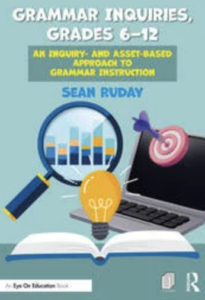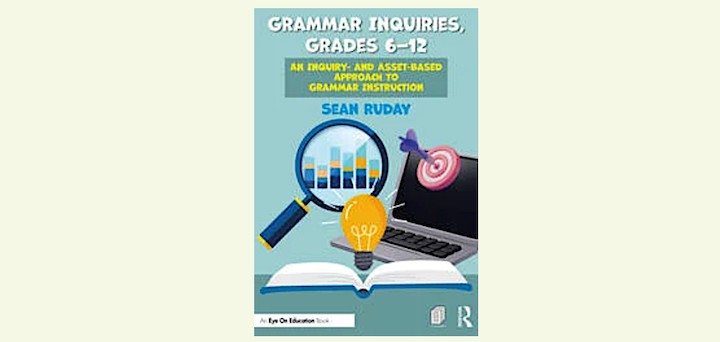Grammar Inquiries, Grades 6–12: An Inquiry- and Asset-Based Approach to Grammar Instruction.
By Sean Ruday
(Routledge/Eye On Education, 2024 – Learn more)
Reviewed by Melinda Stewart

 In Grammar Inquiries, Grades 6–12: An Inquiry- and Asset-Based Approach to Grammar Instruction, Sean Ruday presents an approach to grammar instruction that prioritizes inquiry-based learning and asset-based practices to foster deeper engagement and understanding.
In Grammar Inquiries, Grades 6–12: An Inquiry- and Asset-Based Approach to Grammar Instruction, Sean Ruday presents an approach to grammar instruction that prioritizes inquiry-based learning and asset-based practices to foster deeper engagement and understanding.
The book challenges traditional, rule-based grammar teaching, advocating for a more dynamic classroom approach where students actively participate in their own language development.

 Ruday begins by challenging grammar instruction that involves rote memorization of isolated rules. Ruday argues for a shift towards inquiry-driven learning, where grammar is seen not as a collection of arbitrary rules but as a toolkit for effective communication and self-expression.
Ruday begins by challenging grammar instruction that involves rote memorization of isolated rules. Ruday argues for a shift towards inquiry-driven learning, where grammar is seen not as a collection of arbitrary rules but as a toolkit for effective communication and self-expression.
Ruday argues that this reframing encourages students to view grammar as an essential tool for clarity and precision. Instead of focusing on isolated rules, Ruday promotes exploring grammar through real-world contexts, encouraging students to understand its role in facilitating more effective communication.
Leveraging student assets
A key strength of Grammar Inquiries, Grades 6–12 is its focus on leveraging students’ existing linguistic assets. Ruday stresses the importance of honoring the lived experiences that students bring to the classroom. This approach reinforces grammar as a tool for clear expression and aims to build on what students already know.
The emphasis on student-centered learning values empowering students to be active participants in their own learning process. When we focus on student inquiry alongside the integration of grammar in authentic contexts, learning tends to become more relevant and meaningful to students.
As I read, I was drawn to the integration of inquiry-based strategies into grammar lessons. Ruday advocates for the use of authentic text analysis, collaborative discussions, and project-based learning activities to engage students in grammar exploration. By modeling and posing thoughtful questions and guiding students through grammar concepts with meaningful contexts, educators can build relationships with their students and foster critical thinking skills that help students apply their grammatical knowledge in a variety of scenarios. These strategies enable students to develop a deeper understanding of grammar’s function and its importance in real-world contexts.
As a long-time second language learner and educator, I find Grammar Inquiries, Grades 6–12: An Inquiry- and Asset-Based Approach to Grammar Instruction aligns well with what I have experienced as a learner and have incorporated in my own classroom. For someone new to the idea of grammar inquiries, this book is a useful tool to get started. For educators who have been using inquiry and authentic text for a while, the book affirms our practice.
Melinda Stewart has been an educator for 30 years. She has an MA in Teaching, Education and Learning and has done graduate work in the areas of English as a Second Language, Reading, Spanish, and most recently English Language Arts. She is currently working as a Spanish teacher and ELM coach at Fairmont Junior Senior High School. Melinda is an MEA and AFT professional development facilitator and trainer who has a deep passion for learning and equity.









